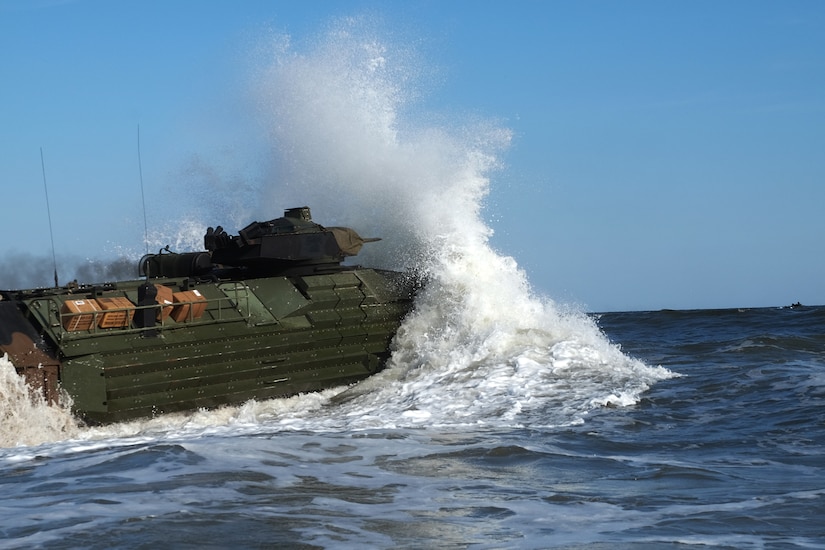By Jim Garamone, Defense.gov
WASHINGTON -- The world’s preeminent defensive alliance is
readying to demonstrate its capabilities in its largest exercise since 2002,
said Navy Adm. James Foggo, the commander of NATO’s Allied Joint Force Command
in Italy.
The exercise brings together 45,000 personnel from the 29
NATO allies, and partner nations Sweden and Finland. “Allies are contributing
about 150 aircraft over 60 ships and 10,000 rolling or tracked vehicles,” Foggo
said.
The purpose of the exercise is to test alliance readiness
and responsiveness. “Let me emphasize that this is an exercise,” he said. “This
is for training, but it is real because the lessons we learned are very real
and they'll benefit us in our desire to become more resilient and stronger
together as an alliance.”
Simply holding the exercise and demonstrating the
capabilities of NATO has a deterrent effect, the admiral said.
NATO has invited observers to the exercise including Russia.
“Exercises like this show that NATO is strong,” he said. “Together, we're more
effective at upholding our common values and preserving peace. Trident Juncture
will prove that in this very unpredictable world … NATO remains an anchor of
stability; 70 years young, 70 years old, the strongest alliance in the history
of Europe.”
Testing Interoperability
Trident Juncture will exercise all aspects of the alliance
and test capabilities in all domains. Air, land, maritime, special operations
and amphibious forces will participate. It is designed to test the
interoperability of national forces.
Foggo’s Canadian deputy, army Lt. Gen. Christian Juneau,
will command the land forces. “I will be where I belong, at sea on either USS
Mount Whitney or bouncing around some of the other ships out there,” he said.
“And it's going to be sporty because this is wintertime. This is the North
Atlantic. And I think it'll be a challenge for all those nations to come up, some
are more used to it than others. The Norwegians are certainly used to that kind
of weather and those kind of seas. The American Marines that come over, this is
going to be a great opportunity for them to fight in the archipelago, fight
without their boots in the sand, and come ashore in Norway and work in cold
weather operations.”
Testing NATO’s 5,000-strong Response Force is at the core of
the exercise, but it also tests logistics. “I call it the sixth domain of
warfare,” he said. “Moving 45,000 people, and 10,000 vehicles, and 60 some odd
ships, and 120 aircraft around the theater is not easy, so this is a test of
our ability to do that rapidly.”
U.S. forces handle logistics on a global scale, and NATO is
looking to develop the same capabilities. “In order to deter, you have to be
present,” Foggo said. “You've got to be there and you've got to be there
quickly.”
NATO’s Trident Juncture Exercise Tests Deterrence
Capabilities
By Jim Garamone, Defense.gov
WASHINGTON -- The world’s preeminent defensive alliance is
readying to demonstrate its capabilities in its largest exercise since 2002,
said Navy Adm. James Foggo, the commander of NATO’s Allied Joint Force Command
in Italy.
The exercise brings together 45,000 personnel from the 29
NATO allies, and partner nations Sweden and Finland. “Allies are contributing
about 150 aircraft over 60 ships and 10,000 rolling or tracked vehicles,” Foggo
said.
The purpose of the exercise is to test alliance readiness
and responsiveness. “Let me emphasize that this is an exercise,” he said. “This
is for training, but it is real because the lessons we learned are very real
and they'll benefit us in our desire to become more resilient and stronger
together as an alliance.”
Simply holding the exercise and demonstrating the
capabilities of NATO has a deterrent effect, the admiral said.
NATO has invited observers to the exercise including Russia.
“Exercises like this show that NATO is strong,” he said. “Together, we're more
effective at upholding our common values and preserving peace. Trident Juncture
will prove that in this very unpredictable world … NATO remains an anchor of
stability; 70 years young, 70 years old, the strongest alliance in the history
of Europe.”
Testing Interoperability
Trident Juncture will exercise all aspects of the alliance
and test capabilities in all domains. Air, land, maritime, special operations
and amphibious forces will participate. It is designed to test the
interoperability of national forces.
Foggo’s Canadian deputy, army Lt. Gen. Christian Juneau,
will command the land forces. “I will be where I belong, at sea on either USS
Mount Whitney or bouncing around some of the other ships out there,” he said.
“And it's going to be sporty because this is wintertime. This is the North
Atlantic. And I think it'll be a challenge for all those nations to come up, some
are more used to it than others. The Norwegians are certainly used to that kind
of weather and those kind of seas. The American Marines that come over, this is
going to be a great opportunity for them to fight in the archipelago, fight
without their boots in the sand, and come ashore in Norway and work in cold
weather operations.”
Testing NATO’s 5,000-strong Response Force is at the core of
the exercise, but it also tests logistics. “I call it the sixth domain of
warfare,” he said. “Moving 45,000 people, and 10,000 vehicles, and 60 some odd
ships, and 120 aircraft around the theater is not easy, so this is a test of
our ability to do that rapidly.”
U.S. forces handle logistics on a global scale, and NATO is
looking to develop the same capabilities. “In order to deter, you have to be
present,” Foggo said. “You've got to be there and you've got to be there
quickly.”







